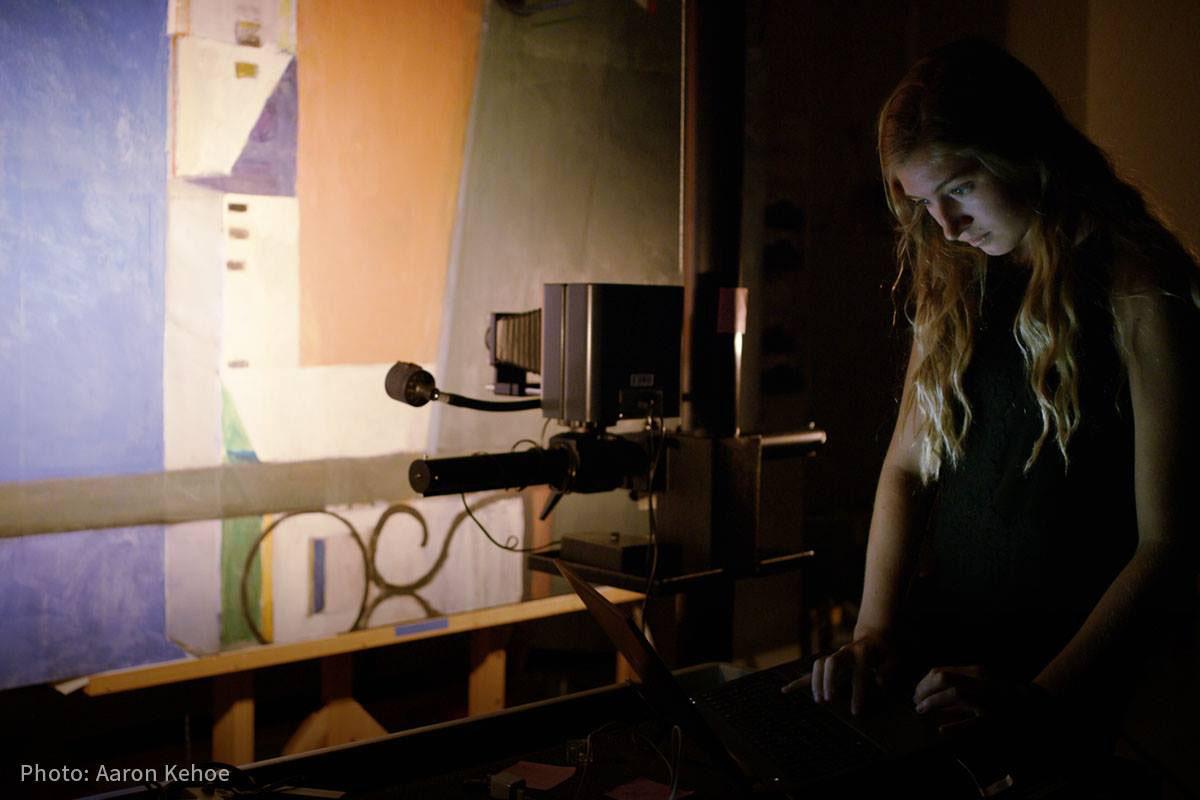Stanford, CA–Stanford student Katherine Van Kirk, ’19, has paired modern technology with old-fashioned and painstaking detective work to reveal several images hidden beneath the surface of artist Richard Diebenkorn’s painting Window (1967). What makes the find particularly exciting is that Van Kirk discovered figurative images executed just as Diebenkorn, Stanford BA ‘49, transitioned from his identification as a founder of the Bay Area Figurative movement to pursuing more abstract work. Now, Van Kirk’s findings are on view at the Cantor in the exhibition Through Diebenkorn’s Window: Transitions in Time, which includes an interactive display that allows visitors to peel back the layers of the painting for themselves.
Van Kirk, an engineering physics major, always dreamed of finding an underpainting, images hidden beneath the surface of a finished work. When the Cantor’s Art+Science Learning Lab put out a call for art-related research projects, she put in a proposal and was selected as a Chen-Yang Fellow in the lab. Soon she was working closely with Susan Roberts-Manganelli, director of the lab, who armed Van Kirk with an infrared camera and sent her into the Cantor’s galleries to see what she could find. “Our lab is the place where science students get to use their analytical skills in new ways,” Roberts-Manganelli said. When Van Kirk pointed the camera at Diebenkorn’s painting, Window, only the second painting she tested, she was amazed to see something revealed under the surface.
With a grant from the Bank of America 2016 Art Conservation Project (ACP), the Art+Science Lab was able to purchase a special infrared reflectography camera, which is capable of more penetrating imaging. Van Kirk has spent hours using the camera to create a patchwork quilt of images of each part of the painting, which she then stitched together into a whole.
"It feels like every day we uncover a new detail below the surface. We initially thought there was only one alternate composition, but just recently, we discovered another layer,” Van Kirk said. “At its heart, my interdisciplinary research is detective work combining art and physics. It’s an incredible way to be spending my time at Stanford."
The images that have been revealed include a sketch of a pair of glasses. The glasses match those worn by Diebenkorn himself, as seen in a self-portrait the artist did in a sketchbook that is part of the Cantor’s collection. These and other images are evidence—in a single painting—of the transitions Diebenkorn was making in his art.
“Katherine’s work is an example of how the Cantor is engaging undergraduates in unique research opportunities and helping create bridges across the campus between the arts and sciences,” said Susan Dackerman, John & Jill Freidenrich Director at the Cantor. “It’s exciting to see technology being used to add to our understanding of an artist’s process and the evolution of his work.”
To have found the multiple compositions beneath a work of Diebenkorn’s adds another chapter to the Cantor’s deep connection with the artist and his estate. Throughout his long career, Diebenkorn used a sketchbook—a "portable studio," as he called it—to capture his ideas. The resulting collection of sketchbooks contains drawings that span the artist's career including gestural renderings of everyday items and a multitude of images of the people who surrounded him over the years, revealing his fascination with the human figure.
After Diebenkorn's death in 1993, his wife, Phyllis, Stanford BA '42, made a gift of over two dozen sketchbooks to the Cantor Arts Center in 2014. These sketchbooks proved invaluable in helping Van Kirk understand the significance of the images she found, explained Jessica Stewart, associate curator of academic engagement, who has worked with Van Kirk on the preparation of the exhibition.
The new exhibition allows visitors to see beneath the surface of the painting using interactive digital media. The artist’s sketchbooks, also on view, support Van Kirk’s conclusions about her discoveries.
This exhibition is organized by the Cantor Arts Center. We gratefully acknowledge support from the Bank of America Art Conservation Project.

